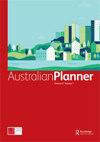Space for mainstreaming? Learning from the implementation of urban forest strategies in metropolitan Melbourne
IF 1.5
Q2 Social Sciences
引用次数: 0
Abstract
Australia is experiencing an accelerated rate of climate-related extreme weather events, and many of the solutions to reduce the exposure to climate-risk are nature-based, governing urban forests, waterways, and stormwater. However, the governance of nature-based solutions in Australian cities is still fragmented and piecemeal, generally lacking a coherent narrative and widespread support. What is needed are institutional spaces that mainstream such solutions. In this paper, we draw on a case study of urban forestry implementation across metropolitan Melbourne, as a lens to examine the creation and evolution of such institutional spaces. We explain the functions and design characteristics of institutional spaces from the perspective of the requirements for establishing and maintaining institutional spaces and what is produced or the outcomes from institutional spaces. The mobilisation and evolution of institutional spaces are important to understand for the impact on the planning and governance of individual cities as well as the metropolitan region. Our key findings frame institutional spaces as relational, learning-oriented, collaborative, and empowering spaces that facilitate transformative agendas and actions for the mainstreaming of nature-based solutions in cities. From these findings, we identify seven recommendations for how practitioners can make the most of institutional spaces.主流化的空间?借鉴墨尔本市城市森林战略的实施
澳大利亚正在经历与气候相关的极端天气事件的加速发生,许多减少气候风险的解决方案都是以自然为基础的,包括管理城市森林、水道和雨水。然而,澳大利亚城市中基于自然的解决方案的治理仍然是支离破碎的,通常缺乏连贯的叙述和广泛的支持。我们需要的是将这些解决方案纳入主流的机构空间。在本文中,我们以墨尔本大都市的城市林业实施为例,来审视这种制度空间的创造和演变。我们从制度空间建立和维持的要求、制度空间产生的产物或结果等角度来解释制度空间的功能和设计特征。机构空间的动员和演变对于理解对单个城市和大都市区的规划和治理的影响非常重要。我们的主要发现将机构空间定义为关系型、学习型、合作型和赋权型空间,这些空间有助于推动城市基于自然的解决方案主流化的变革议程和行动。根据这些发现,我们为从业者如何充分利用机构空间提出了7项建议。
本文章由计算机程序翻译,如有差异,请以英文原文为准。
求助全文
约1分钟内获得全文
求助全文

 求助内容:
求助内容: 应助结果提醒方式:
应助结果提醒方式:


